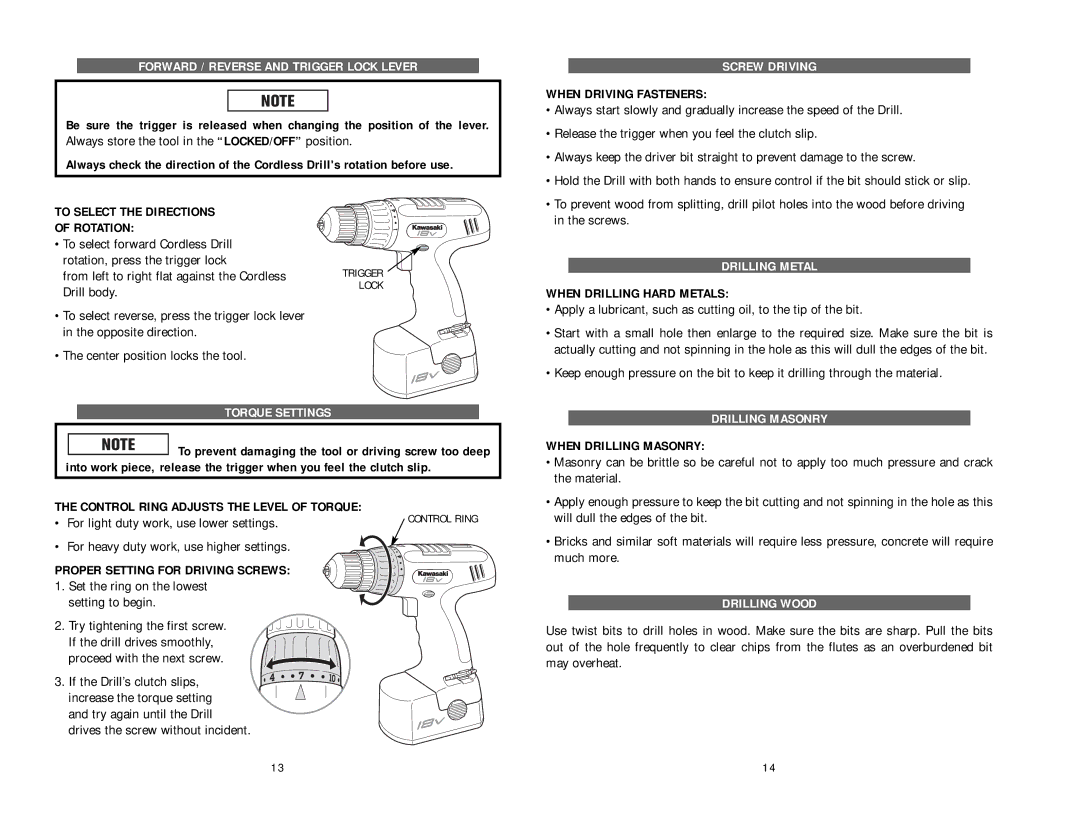
FORWARD / REVERSE AND TRIGGER LOCK LEVER
Be sure the trigger is released when changing the position of the lever. Always store the tool in the “LOCKED/OFF” position.
Always check the direction of the Cordless Drill's rotation before use.
TO SELECT THE DIRECTIONS |
|
OF ROTATION: |
|
• To select forward Cordless Drill |
|
rotation, press the trigger lock | TRIGGER |
from left to right flat against the Cordless | |
Drill body. | LOCK |
|
• To select reverse, press the trigger lock lever in the opposite direction.
• The center position locks the tool.
TORQUE SETTINGS
![]() To prevent damaging the tool or driving screw too deep into work piece, release the trigger when you feel the clutch slip.
To prevent damaging the tool or driving screw too deep into work piece, release the trigger when you feel the clutch slip.
THE CONTROL RING ADJUSTS THE LEVEL OF TORQUE: | CONTROL RING | |
• | For light duty work, use lower settings. | |
• | For heavy duty work, use higher settings. |
|
PROPER SETTING FOR DRIVING SCREWS: 1. Set the ring on the lowest
setting to begin.
2.Try tightening the first screw. If the drill drives smoothly,
proceed with the next screw.
3. If the Drill’s clutch slips, increase the torque setting and try again until the Drill drives the screw without incident.
SCREW DRIVING
WHEN DRIVING FASTENERS:
•Always start slowly and gradually increase the speed of the Drill.
•Release the trigger when you feel the clutch slip.
•Always keep the driver bit straight to prevent damage to the screw.
•Hold the Drill with both hands to ensure control if the bit should stick or slip.
•To prevent wood from splitting, drill pilot holes into the wood before driving in the screws.
DRILLING METAL
WHEN DRILLING HARD METALS:
•Apply a lubricant, such as cutting oil, to the tip of the bit.
•Start with a small hole then enlarge to the required size. Make sure the bit is actually cutting and not spinning in the hole as this will dull the edges of the bit.
•Keep enough pressure on the bit to keep it drilling through the material.
DRILLING MASONRY
WHEN DRILLING MASONRY:
•Masonry can be brittle so be careful not to apply too much pressure and crack the material.
•Apply enough pressure to keep the bit cutting and not spinning in the hole as this will dull the edges of the bit.
•Bricks and similar soft materials will require less pressure, concrete will require much more.
DRILLING WOOD
Use twist bits to drill holes in wood. Make sure the bits are sharp. Pull the bits out of the hole frequently to clear chips from the flutes as an overburdened bit may overheat.
13 | 14 |
